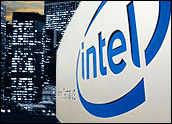
Semiconductor chip giant Intel reported better-than-expected financial results for the third quarter late Tuesday, but it wasn’t enough to buoy the Santa Clara, Calif.-based company’s stock or inject any new life into the broader chip market.
Net income at Intel rose 12 percent year-over-year to US$2.01 billion. However, top-line revenue rose just 1 percent to $10.2 billion.
Intel forecast fourth-quarter sales of $10.1 billion to $10.9 billion, which is in line with Wall Street expectations of $10.77 billion. The company also forecast its gross margins would remain relatively flat at 59 percent.
Intel stock rose to $16.42 per share in early trading, while share prices of Intel competitors such as Advanced Micro Devices, Texas Instruments and Infineon Technologies faltered. However, Intel sank by more than 2 percent later in the day, as the broader market once again plunged.
The Dow Jones Industrial Average was down a whopping 5.48 percent and the Nasdaq National Market was down 5.78 percent at press time.
A Grim Outlook
“Business was driven by solid notebook sales and Intel’s broad reach geographically,” Tom Beermann, an Intel spokesperson, told the E-Commerce Times. “We’re not dependent on the U.S. market, which only constitutes 20 percent of our sales. We also benefited by areas that have not been affected by the recent economic turmoil. Asia was good, and Japan was surprisingly good.”
The company’s fourth-quarter outlook is prudent, Beermann said, given the state of the economy.
“The revenue range we provided is wider than what we normally provide,” he said. “On Dec. 4, we’ll give investors an update on Q4 financial progress. In terms of the corporate market, we indicated during Q3 that we see some softness there.”
Despite Intel’s meeting Wall Street expectations, the outlook for the company and other semiconductor stocks looks grim.
“The question is what happens going forward,” Robert Burleson, an equity analyst with Canaccord Adams, told the E-Commerce Times. “There’s still uncertainty about 2009, especially on the corporate spending side. People understand there’s a slowdown there.”
Softness in the corporate market has manifested itself in soft laptop sales, and it’s likely to stay that way for the foreseeable future, said Burleson.
“Corporate will probably stay weak through the first half of next year, according to our sources in the manufacturing channel for PCs,” he said, “and I don’t think anyone’s taken into account that there’s going to be a slowdown in consumer spending as well.”
Though Intel’s gross margins are expected to hold steady in the fourth quarter, the outlook beyond that is less clear.
“Gross margins could be under pressure next year because of this new focus on these netbooks, which are lower-end laptops,” noted Burleson.
Potential for Layoffs
With a large hoard of cash and negligible debt, Intel is somewhat insulated from a slowdown in corporate and consumer spending on consumer electronics.
“No one’s worried about [Intel’s] debt or their cash on hand,” Burleson said.
However, if the economy continues to weaken, it’s possible Intel could follow past behavior and cut jobs in an effort to conserve cash.
“I’d say there is no reason Intel wouldn’t [cut jobs] if they have to,” he said. “They’ve done it in the past and jettisoned noncore businesses when there’s been a prolonged downturn. Those with higher headcounts will have to make reductions.”






















































Social Media
See all Social Media